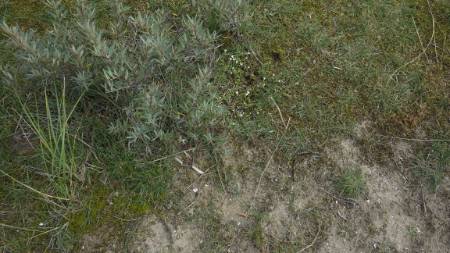The NaturePlus Forums will be offline from mid August 2018. The content has been saved and it will always be possible to see and refer to archived posts, but not to post new items. This decision has been made in light of technical problems with the forum, which cannot be fixed or upgraded.
We'd like to take this opportunity to thank everyone who has contributed to the very great success of the forums and to the community spirit there. We plan to create new community features and services in the future so please watch this space for developments in this area. In the meantime if you have any questions then please email:
Fossil enquiries: esid@nhm.ac.uk
Life Sciences & Mineralogy enquiries: bug@nhm.ac.uk
Commercial enquiries: ias1@nhm.ac.uk
-
Currently Being ModeratedOct 5, 2017 9:20 PM (in response to f8419e5f47f6ffcc41aecc7f26948af69ff22e99)Re: Unusual plant specimen in old dunes
Hello Michael,
Welcome to NaturePlus.
I have been puzzling over this for a couple of days. I thought it looked familiar but couldn't think what it was, and my books were no help.
This evening I have remembered, it's definitely a plant out of place which is why I didn't get it quicker, I think. It's Bacopa, a summer hanging basket/container plant. The Latin name is Sutera cordata, though I think it may now be called Chaenostoma cordatum.
I know it as a tender perennial, but perhaps it can survive the winter in the right location, don't know whether that would include dunes though!
Is the location near any plant nurseries? That may be the source, rather than a garden escape.
Regards Lucy
-
Currently Being ModeratedOct 5, 2017 9:58 PM (in response to lucy)Re: Unusual plant specimen in old dunes
Hello Lucy
Lovely surprise. That is most interesting. I am truly grateful for your reply. There is no nursery nearby for several kilometres but beyond that dozens. The plant has been there now for at least 2 years. It is very near the sea and there has been no severe frost here for several years. Rabbits don't graze the specimen, everything around it, but it remains a compact 6" diameter. I notice the leaves are more hirsuit than the available illustrations of the cultivated versions.
Shortly I leave Haarlem for the winter but shall certainly check again in the spring. Migrating birds including many buntings and finches pass through this particular dunes complex. They might have raided a nursery or if the plant's endemic environment is between here and Africa it could have hitched a lift. I thought it was either a sport or an alien but it didn't seem to fit anywhere despite my guesses! Taking a piece seemed inappropriate if it proved a rarity. I assume it isn't a salad plant? If so human agency is probable.
My normal environment is in the mountains of Cabo de Gata, Almeria, Spain - at least for the time being -where I keep a NH website.
Again, very many thanks.
Michael
-
Currently Being ModeratedOct 8, 2017 7:39 PM (in response to f8419e5f47f6ffcc41aecc7f26948af69ff22e99)Re: Unusual plant specimen in old dunes
There is a plant called Water Hyssop, Bacopa monnieri, which is to some extent edible and apparently used in herbal medicine. It has different shape leaves to this type of Bacopa, which is not edible. You could be right in supposing that it arrived with the help of a bird.
I see the leaves have a red tinge to them which could be the time of the year (I've only seen it in spring and summer) or probably more likely it's a sign of low nutrient levels in the soil, not surprising given that it's an old dune system. This would also explain the small size of the plant, I would expect it to be at least twice the diameter after one year, never mind 2 or more.
It is considered half-hardy rather than tender, my mistake, so it could certainly survive the winter in a sheltered position.
Lucy
-
Currently Being ModeratedOct 13, 2017 12:26 PM (in response to lucy)Re: Unusual plant specimen in old dunes
-
-
-
-
Currently Being ModeratedMay 5, 2018 11:41 AM (in response to f8419e5f47f6ffcc41aecc7f26948af69ff22e99)Re: Unusual plant specimen in old dunes
We were hoping to keep an update on this but checking in March we discovered the plant had been trowelled up,uite definitely human agency. It would be sad if its site had been identified through this forum! Probably a plantsman wanted a breeding source, it is Holland after all. We shall continue to check.
-
Currently Being ModeratedMay 6, 2018 6:45 PM (in response to f8419e5f47f6ffcc41aecc7f26948af69ff22e99)Re: Unusual plant specimen in old dunes
Oh that's a shame, at least it presumably survived another winter.
Hopefully this site had nothing to do with it being taken, perhaps someone just came across it and thought it looked interesting. It's illegal to dig up plants from the wild in the UK (although it does still happen of course) but the laws may be different for Holland.
Lucy
-
Currently Being ModeratedMay 6, 2018 7:30 PM (in response to lucy)Re: Unusual plant specimen in old dunes
The Kennemerduinen in North Holland is a National Park and it is illegal there also to pick flowers or remove plants. That obviously doesn't deter some and guardianship is both costly and difficult over a public resource of this area. We are hoping there were signs of its having seeded but then any seedlings are also vulnerable to similar action once discovered. We shall keep looking.
Thank you for your continued interest Lucy.
Michael
-
-
Actions
More Like This
- Retrieving data ...
What the symbols mean
- "correct" answer available
- "helpful" answer
- Contact and enquiries
- Accessibility
- Website terms of use
- Information about cookies
- © The Trustees of the Natural History Museum, London



